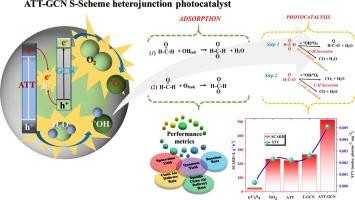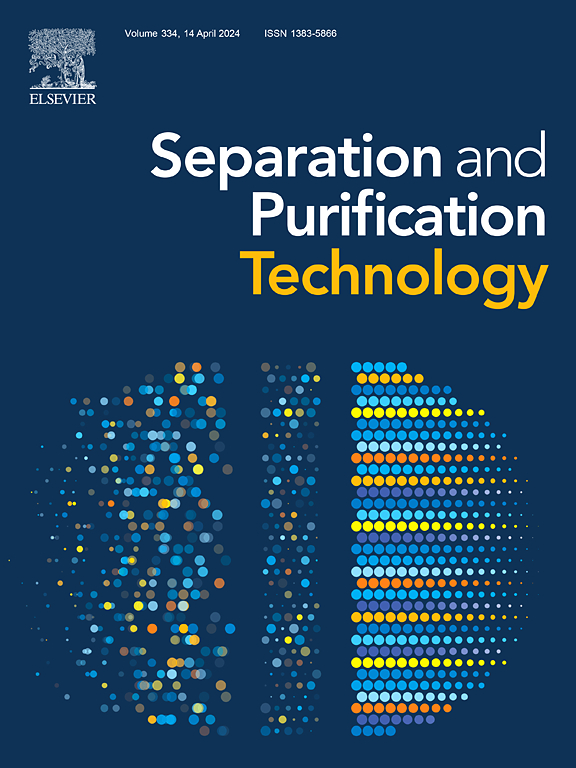Understanding oxidation potential and degradation mechanism of acid-treated TiO2 coupled g-C3N4 S-scheme heterojunction photocatalyst for the removal of gaseous formaldehyde
IF 8.1
1区 工程技术
Q1 ENGINEERING, CHEMICAL
引用次数: 0
Abstract
In this work, a step (S)-scheme heterojunction catalyst is synthesized by coupling acid-treated TiO2 (ATT) with graphitic carbon nitride nanosheet (g-C3N4: GCN) and used for adsorption-photocatalytic removal of gaseous formaldehyde (FA: 100 - 500 ppm). The acid treatment of TiO2 proves to be an effective approach for improving the surface porosity of ATT with more abundant active sites for efficient catalytic reactions. Similarly, the S-scheme heterojunction displays superior redox potential (i.e., availability of free e- at conduction band of GCN (reduction potential of −0.485 eV/NHE) and free h+ at valance band of ATT (oxidation potential 2.79 eV/NHE)). As such, in a dynamic packed-bed flow reactor, the improved textural and optical properties of ATT-GCN (bed mass = 10 mg) offer outstanding adsorption and photocatalytic oxidation potential, effectively removing 86% of 200 ppm FA vapor at a reaction rate of 70.2 nmole mg−1 min−1 under slightly humidified conditions (e.g., 20% relative humidity (RH) and 21% O2) when exposed to 32-W UV-A light source. Under these operational conditions, the ATT-GCN achieves the superior performance metrics (e.g., quantum yield of 5.1E-02 molec. photon-1, space–time yield of 5.1E-03 molec. photon-1 mg−1, and specific clean air delivery rate of 515.4 L g-1 h−1). In-situ Kelvin probe microscope analysis of ATT-GCN postulates the formation of a strong built-in electric field to improve the separation of charge carriers. Considerations on the degradation pathway and intermediate dynamics with the aid of in-situ DRIFTS analysis suggest that the presence of water molecules (e.g., 20% RH) is beneficial for accelerating the oxidation and mineralization of FA molecules relative to a dry gas stream. The overall outcomes of this work are expected to help deliver new paths for the construction of advanced photocatalytic systems for upscaled applications toward air quality management.

了解酸处理二氧化钛耦合 g-C3N4 S 型异质结光催化剂在去除气态甲醛中的氧化潜能和降解机理
本研究通过酸处理二氧化钛(ATT)与氮化石墨碳纳米片(g-C3N4: GCN)的偶联合成了一种阶跃(S)型异质结催化剂,并将其用于吸附-光催化去除气态甲醛(FA:100 - 500 ppm)。事实证明,对二氧化钛进行酸处理是提高 ATT 表面孔隙率的一种有效方法,可为高效催化反应提供更丰富的活性位点。同样,S 型异质结显示出卓越的氧化还原电位(即 GCN 传导带的自由 e-(还原电位 -0.485 eV/NHE)和 ATT 价带的自由 h+(氧化电位 2.79 eV/NHE))。因此,在动态填料床流动反应器中,ATT-GCN(床层质量 = 10 mg)的质地和光学特性得到了改善,具有出色的吸附和光催化氧化潜力,在轻微增湿条件下(如 20% 相对湿度 (RH) 和 21% 氧气),当暴露于 32-W UV-A 光源时,以 70.2 nmole mg-1 min-1 的反应速率,可有效去除 86% 的 200 ppm FA 蒸汽。在这些操作条件下,ATT-GCN 实现了卓越的性能指标(例如,量子产量为 5.1E-02 摩尔光子-1,时空产量为 5.1E-03 摩尔光子-1 毫克-1,特定洁净空气输送率为 515.4 升克-1 小时-1)。对 ATT-GCN 的原位开尔文探针显微镜分析表明,ATT-GCN 形成了一个强大的内置电场,以改善电荷载流子的分离。借助原位 DRIFTS 分析对降解途径和中间动态的考虑表明,相对于干燥气流,水分子的存在(如 20% 相对湿度)有利于加速 FA 分子的氧化和矿化。预计这项工作的总体成果将有助于为构建先进的光催化系统提供新的途径,从而扩大在空气质量管理方面的应用。
本文章由计算机程序翻译,如有差异,请以英文原文为准。
求助全文
约1分钟内获得全文
求助全文
来源期刊

Separation and Purification Technology
工程技术-工程:化工
CiteScore
14.00
自引率
12.80%
发文量
2347
审稿时长
43 days
期刊介绍:
Separation and Purification Technology is a premier journal committed to sharing innovative methods for separation and purification in chemical and environmental engineering, encompassing both homogeneous solutions and heterogeneous mixtures. Our scope includes the separation and/or purification of liquids, vapors, and gases, as well as carbon capture and separation techniques. However, it's important to note that methods solely intended for analytical purposes are not within the scope of the journal. Additionally, disciplines such as soil science, polymer science, and metallurgy fall outside the purview of Separation and Purification Technology. Join us in advancing the field of separation and purification methods for sustainable solutions in chemical and environmental engineering.
 求助内容:
求助内容: 应助结果提醒方式:
应助结果提醒方式:


